I grew up calling it butter-and-eggs, a pretty little plant in the meadows of New York and Ohio.
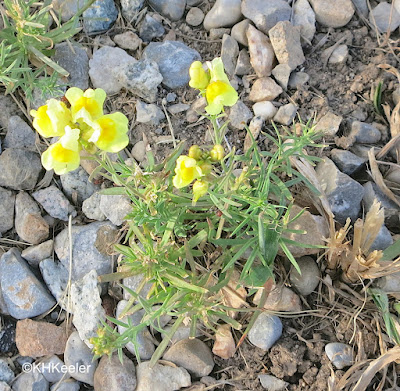 |
| butter-and-eggs, Linaria vulgaris, yellow toadflax |
We see the world around us, but we can't see what it was. Visiting San Francisco in November, the National Park Presidio was full of informational signs about the history of the site, pointing to multiple transformations since Spain established a fort there in 1776. (Native Americans left their mark too, as mounds of discarded sea shells, which have been dated back to 740 CE).
Some changes were dramatic. This is the creek as I saw it, the drainage full of shrubs (Thompson Reach).
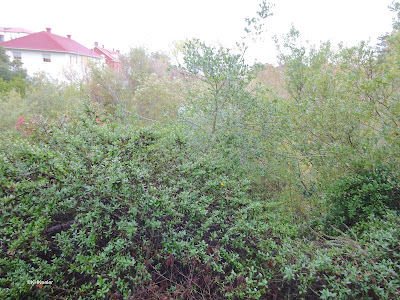 |
| Stream zone that was covered, then restored |
My parents had a pretty little tree in the corner of the yard, a mountain ash. As a kid, I paid it very little attention. Meanwhile, I read the Lord of the Rings, and, like many people, loved the ent Quickbeam. In the book, Quickbeam speaks lovingly of rowan trees, "There are no trees of all that race, the people of the Rose, that are so beautiful to me. [They] grew and grew, till the shadow of each was like a green hall, and their red berries in the autumn were a burden, and a beauty, and a wonder."[Tolkien p.87] I'd known of Quickbeam for several years, ages 9 to about 16, when I discovered that rowan trees are also called mountain ash. The mountain ash was suddenly cool, like Quickbeam.
 |
| moutain ash, rowan, Sorbus aucuparia |
We curtailed our travel--or it was curtailed for us--due to covid. Now we're starting to get out again, finding that travel is changed and so are we. We went in mid-November to San Francisco. My husband and I lived in the Bay Area, both San Francisco and Berkeley, in the 1970s, and have visited many times since.
 |
| Golden Gate Bridge |
Four o'clocks are flowers I've loved since childhood.
And, since I was a child, what I liked best were the seeds. Big, round with a bulge at one side, such fun to collect! You can see them in the photo below, round black shapes, for example at the base of the flower in the center.
 |
| four o'clocks with seeds |
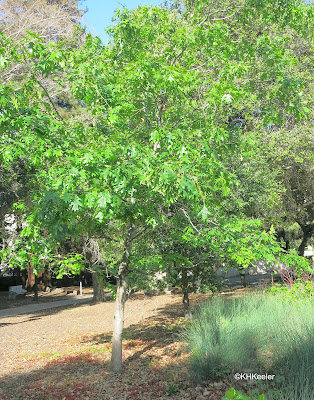 |
| oak, Colorado |
Purple prairie clover is a very pretty native wildflower. It stands about two feet tall (sometime 3'), in a compact clump. The flowers are light purple and it will flower all summer. Most abundant in the central Midwest, its native range included meadows in the eastern U.S. and forest gaps in the mountain West, moist grasslands in the desert Southwest, and warmer sites in southern Canada. Today, it has been planted even more widely, but its native populations in Michigan and Ohio are presumed extinct, and it is endangered in Tennessee.
 |
| purple prairie clover Dalea purpurea |
I've been writing this blog weekly since 2013, describing places or plants, or botanical ideas. Most weeks I include references. Reading other people's blogs as I worked on English ivy, I noted, again, that few of them include references. So why do I? Why go to that extra work?
What the references do is to show you, the reader, where I got my material. It is an academic thing, of course. But knowledge is built on knowledge. I have first-hand observations, but I get a lot of information from other people. In academia, it is important to give those people credit. Here on the internet, manners are different, but the core reason for including references is to let readers know where the information came from remains critical.
 |
| grapevine, as in "I heard it through the grapevine" |
If the first reason for listing references is to give credit where credit is due, the second is to be transparent about where the facts and ideas came from. That's the one I'm going to talk about.
English ivy, also called common ivy or just ivy, (Hedera helix, ginseng family, Araliaceae) is a large woody vine native to central Europe. (See last week's blog about its botany link). It was and is conspicuous, a plant most people know. The plant is big, climbing and clinging, long-lived and evergreen. All of these feature in its rich folklore.
Blue grama and hairy grama, Bouteloua gracilis and B. hirsuta, respectively, are short grasses that are very important in the dry plains of the Midwest and West. They can be found from Canada and Mexico and east and west to coastal states. I am talking about them together in this post because they are hard to tell apart. A few specialists can tell their leaves apart, but, mostly, grassland ecologists don't try, relying on the seed heads to recognize the differences.
 |
| hairy grama, Bouteloua hirsuta |
I like plants. I have a yard and garden. This week, weeding, I contemplated weeds. What exactly are they?
"Weed" is a wonderful concept. It is totally human; a weed is a plant that interferes with human activity, which can be reduced to "a plant in the wrong place." I checked the American Weed Science Society's website--they dedicate their careers to controlling weeds, so need a good working definition--and that website defines a weed as "a plant that causes economic losses or ecological damage, creates health problems for humans or animals, or is undesirable where it is growing."
Visiting New Mexico, you can't miss the big cacti. Prickly pears stand two to three feet tall, not hugging the ground like the ones in Colorado. Chollas can be more than eight feet tall.
In July, the tree cholla (Cylindropuntia imbricata) was flower. With deep rose-purple flowers, it was doubly noticeable.
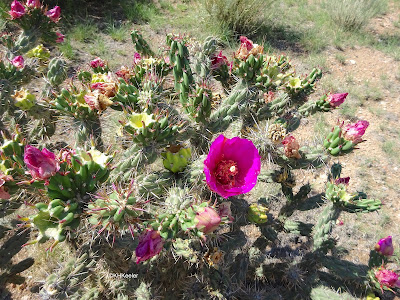 |
| tree cholla, Cylindopuntia imbricata, in flower |
I taught ecology for years. The text books feature dramatic examples of ecological principles--camouflage illustrated with a big green katydids shaped like a leaf, mimicry illustrated by a nonvenomous snake banded like a coral snake, or an example of mutualism with an orchid and exotic bee--almost always tropical. Which tended to make you think that to see biology you should go to the tropics. In fact, though, those basic principles--camouflage, mimicry, mutualism--and all the other pillars of ecology--predation, parasitism, competition--are everywhere.
As the summer winds down, splashes of gold appear on the roadsides and in the prairies and meadows: goldenrod! Depending on where you are, you see a different group of goldenrod species, but they are found all across North America. In fact, goldenrods are a predominantly North American group; there are about 100 species, of which 77 are native to North America, 8 to Mexico, 4 to South America, and 6 to 10 to Eurasia.
However, answers from "experts" that assume what I want in my garden really annoy me.
In the mountains north of Taos, New Mexico, we hiked the Nordski Trail. It is a trail for cross country/Nordic skiers, including beginners, and so relatively level. We saw lovely vistas and wonderful flowers.
This post is about an important, useful plant that people walk by without noticing. Or, since it is mostly stem, look right through. A native wildflower, greenthread is found from Michigan to Arkansas and west to the Pacific Coast. It is not rare. But it tends to go unnoticed.
 |
| Hopi tea greenthread, Thelesperma megapotamicum |
The name greenthread is used by the USDA for the entire genus Thelesperma, but western Nebraska only has the most widespread species, Thelesperma megapotamicum, called Hopi tea greenthread by the USDA to distinguish it from its relatives. Thelesperma megapotanimium is quite a mouthful; saying greenthread is easier. Thelesperma means “nipple seed” and refers to the shape of the seed on the first species described for science, a character not easily seen in other species of Thelesperma.
 |
| Thelesperma megapotamicum flowering in the grassland |
The species epithet megapotamicum uses the Greek mega, large, and potam- from potamos, a river, and the -icum ending makes it possessive, so “of the big river.” The big river meant the province of Rio Grand do Sul in southern Brazil. [Geeky botanical detail: Frederick Sellow (1789-1830) collected plants in Brazil in the early 1800s and sent the specimens back to the herbarium in Berlin. Other botanists, in particular Christian Konrad Sprengel (1750-1816) organized the specimens and named them. Sprengel named a plant of Sellow’s Bidens megapotamica, because Sellow had said it was “of Rio Grande” and Sprengel didn’t know that referred to Rio Grande a province, so turned the location into “big river,” in Greek. Otto Kuntze (1843-1907) moved the plant to the genus Thelesperma from Bidens.] Thelesperma megapotamicum is found in the United States and northern Mexico, and southern Brazil, Uruguay, and northern Argentina, but not the tropics in between, a quite peculiar distribution. (Most of the North American references don't seem aware that this plant is also found in South America, but see the GBIF map link).
North American botanists seem to think that Hopi tea greenthread is native to dry grassland and forests from Texas to South Dakota, west to Wyoming and south to Arizona, and that its wider U.S. distribution is a result of rather recent spread. Current distribution maps show it in states from Michigan, to Kentucky, to Arkansas, west to Nevada and California. Botanical writers imply that recent human activity introduced greenthread to these places, though I can’t find anyone who says whether it was planted for tea and escaped or moved on its own along roadsides and trails. In all, Hopi tea greenthread has a very wide distribution—South and North America; you might run into it in all sorts of places.
Hopi tea greenthread has several widely-used common names. I did a double-take when I realized that the little prairie plant I knew as greenthread was also the important Hopi tea. When you meet a plant in a native prairie, nothing about it says it is a famous tea. Southwestern sources prefer the name Indian tea, and make the point that many tribes drink it, not just the Hopi. Plants for a Future calls it Navajo tea and gives the name Hopi tea to the related Thelesperma gracile. It is also widely called cota. Cota is the common and scientific name of a genus in the sunflower family that includes many plants used for tea in the U.S. Southwest and into Mexico, so calling greenthread cota is, loosely, calling it “tea.” Some places it is just called wild tea. There must also be South American common names, but I couldn't find them.
You won’t easily mistake Hopi tea greenthread for other greenthreads. Although there are nine species of greenthread, Thelesperma, in the United States, only Hopi tea greenthread lacks ray florets. That is the source of another common name for Hopi tea greenthread, rayless greenthread.
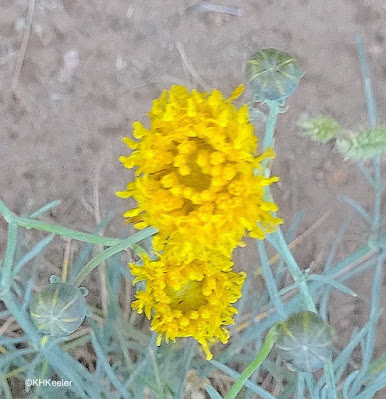 |
| Hopi tea greenthread, open flowers |
While Hopi tea greenthread is pretty recognizeable, it is easily overlooked. Why is it missed? It is mostly stem. The leaves are narrow, well, thread-like. When it flowers, there's a cluster of small disc florets, but no ray florets, so the flowers never seem to open. It is in the sunflower family, Asteraceae, with the same basic flower head structure as a sunflower, just without the ray florets, the little flowers around the outside that in sunflowers have the petals. The flower head becomes a seed head without looking very different than when it was in bud or in full flower.
Greenthread’s leaves are small and stem-like. Leaves that are longer than they are broad, and just generally small, make plants more drought-tolerant, because, for leaves, they lose the least water; when it gets too dry for narrow little leaves, plants have green stems without leaves (cacti) or leaves that fall off in the dry season (creosote bush). Greenthread’s green stems undoubtedly conduct photosynthesis and supplement the work of the leaves. It is a perennial that grows in regions with recurrent drought, so water efficiency is important. Its thready shape might also result in it being overlooked by rabbits and elk, as well as by humans, a few stems hidden among other plants.
Despite the fact that the flowers don’t seem showy to us, they attract a wide array of butterflies and bees. I only found one insect for which it is the host plant, the dainty sulfur butterfly, Nathalis iole (Pieridae) (see butterfly: link) but likely there are other insects that rely on eating this widespread native plant.
Under good conditions, Hopi tea greenthread flowers from late spring through October. In the west it grows from about 1000 ft. elevation up to almost 10,000 ft., in openings in desert scrub, oak/juniper woodlands and pine forests.
 |
| a tangle of Hopi tea greenthread |
Why is Hopi tea greenthread important? You already figured it out: as tea. Greenthread is considered to make the best wild plant tea across New Mexico, Arizona, Utah, and Colorado, and likely farther. Generations of people, all the regional tribes as well as both English and Spanish speaking settlers, have brewed it for tea. Dried plants are infused in hot water, making a golden tea with a slightly smoky flavor, as easily as with a tea bag.
Ethnobotanical and foraging sources agree that tea from greenthread is outstanding, but I suspect it would be easy to get into an argument about how to make the best tea from greenthread. According to Native American Ethnobotany, the Chiricahua and Mesaclero Apache and the Navajo made tea of leaves and young stems; the Hopi used flowers and stem tips; the Keres brewed the whole aboveground plant; the Keresan used leaves and roots; the Ramah Navajo used leaves and flowers; the Tewa just the leaves. Doubtless, each of these people would argue that their way was best. It is a rich area for experimentation if you have greenthread available.
Greenthread has long been used in folk medicine. The tea is slightly diuretic so it is drunk as a treatment for urinary problems. And a cup settles the stomach. Tribes also used it to treat colds, toothache, and muscle cramps. It is still widely used medically.
 |
| a big greenthread plant in flower |
Greenthread also makes an excellent dye. Navajo, Hopi, and other dyers of the Southwest produced bright, durable colors, from greenthread. The hues ranged from golden orange to bright yellow, depending on what mordants (metal ions) or other plants were added. It dyed wools and cottons, and even the usually-hard-to-dye baskets. "Greenthread" refers to how the plant looks, not the dye colors it produces. The plants are so skeletal that a lot of them are needed to make a strong color. I have wanted to dye with greenthread for years, but I have never seen enough plants at one time to make more than a tiny cup of dye. Apparently where Navajo and Hopi dyers forage for dye plants, greenthread can be abundant.
Watch for this inconspicuous plant!
 |
| Hopi tea greenthread, in flower, in the foreground |
Comments and corrections welcome.
References
Dunmire, W. W. and G. D. Tierney. 1995. Wild Plants of the Four Corners. Museum of New Mexico Press. Santa Fe, NM.
Dunmire, W. W. and G. D. Tierney. 1997. Wild Plants and Native Peoples of the Pueblo Province. Museum of New Mexico Press. Santa Fe, NM.
Global Biodiversity Information Facility. Thelesperma megapotamicum (Spreng.) Kuntze. 1898. link Accessed 8/12/21.
Moerman, D. E. 1997. Native American Ethnobotany. I used the printed book but here's the link to the database online link
Southwest Desert Flora. Thelesperma megapotanicum Hopi tea greenthread link Accessed 8/10/21.
Plants for a Future. Thelesperma megapotamicum - (Spreng.) Kuntze. link Accessed 8/13/21.
Sherff, E. E. 1923. New or Otherwise Noteworthy Compositae. Botanical Gazette. 76: 78-94.
Strother, J. L. Theseperma megapotamicum (Sprengel) Kuntze. Flora of North America link Accessed 8/9/21
Kathy Keeler, A Wandering Botanist
More at awanderingbotanist.com
Join me on Facebook: https://www.facebook.com/AWanderingBotanist
I went on a week's vacation to northern New Mexico in mid-July. We hiked and went to botanic gardens, but the best moment of wildflower spotting was the unexpected one. A field of flowers on the roadside.
When I stepped out of the car, all about my feet was the most wonderful diversity of flowers!
Venturing from my Colorado home into the tropics, practically all of the plants change. It has always worked best for me to learn the plant and then learn its proper name. Consequently red-balls-of-flowers-that-look-like-grappling-hooks eventually becomes ixora. I've recognized ixora a long time, but only recently gotten a proper name on it.
 |
| Ixora |
We're far enough into the growing season that the bindweeds are flowering and the dandelions are ready for a second round of flowers. I try to weed part of the yard every day.
One thing I noticed was that although my lawn started the season full of dandelions, my prairie did not. My prairie is maybe 500 square feet that I planted with native grasses and forbs (non-grass herbs) a decade ago. It isn't a great success--some weedy grasses are too common--but I don't water it and my maintenance is confined to weeding out exotics and occasionally cutting back the grasses to mimic natural disturbance such as bison grazing. By the time I got to the 800th tiny dandelion plant in the lawn--an area the size of the prairie--I was struck by the fact that there were only a couple dandelions in the prairie.
 |
| my "prairie" |
What does that suggest?
One deduction is about plant communities; healthy native plant communities are hard for aliens to invade. Not impossible, but much more resistant than most lawns and gardens. (Commercial weed control websites say much the same; make your grass healthy and thick to reduce dandelions.) Ecologists noticed this pattern long ago and made it into an axiom. But they had to retreat when they found example after example of exotics invading good or pretty good native communities. You can't count on a community keeping weeds out, for two reasons. One is, most of our native communities have at least minor recurrent disturbance from humans (hiking trails!) along which invading weeds can move, little gaps of open ground welcoming the weed seed. Secondly, among all the weeds in the world, there will be one that can invade any particular native ecosystem. The closed community keeps out 99 weeds, but that one gets in. My prairie isn't dandelion-free, but there were only a dozen plants, nothing like the number in my rather neglected lawn. So it is generally true that healthy native ecosystems resist invasion.
 |
| my "prairie" |
 |
| my bluegrass lawn |
The second idea I took from the distribution of my dandelions was about dandelions themselves. We hate them as weeds, but they are plants adapted to lawns and yards, and to moderately disturbed paths and roadsides. They don't grow well in prairies, forests, or deserts. Thus, horrible weeds are a function of both the weed and the habitat. Particular plants are bad weeds in habitats where they grow well, but often they are unaggressive in other habitats. I am growing both creeping buttercup (Ranunculus repens, buttercup family, Ranunculaceae) and creeping Jenny (Lysimachia nummularia, primrose family, Primulaceae) as ground covers. They are not very invasive in my yard. I read about people in Ohio fighting to keep them from taking over. I don't see that. But Colorado is much drier than Ohio, and apparently creeping buttercup and creeping jenny like more rain that my yard provides.
 |
| creeping buttercup, Ranunculus repens |
 |
| creeping jenny, Lysimachia nummularia |
We put these ideas together for the seeds and plants we buy, but not so often for the weeds that trouble us. The aggravating weeds are the ones for which my yard has their favorite combination of growing season, water, soil, shade, etc. My neighbor's shadier yard will favor slightly different weeds. If I removed my trees and stopped supplemental watering, I'd significantly change the combination of weeds I fight.
 |
| early spring dandelion in the lawn |
To the degree that yards across the U.S. resemble each other, with Kentucky bluegrass (Poa pratensis, grass family, Poaceae, originally from Eurasia) and the the growing conditions it likes, we all share the weeds that also like those conditions
Alas, for all my wisdom, I will still have to patrol my lawn, digging out dandelions, pulling other weeds.
 |
| another dandelion! --between the flowerbeds |
But my conclusion is also that there will always be weeds. If dandelions suddenly ceased to exist, some other plant would take over the spots the dandelions vacated. And, "be careful what you wish for." Dandelions are hard to kill, but they are not spiny or toxic and can be eaten if you are ever in a famine.
Comments and corrections welcome.
Kathy Keeler, A Wandering Botanist
More at awanderingbotanist.com
Join me on Facebook: https://www.facebook.com/AWanderingBotanist
Walking in Boulder (earlier blog), many of the "wildflowers" were European species that have become naturalized in the U.S. Some are sufficiently common to be recognized as weeds. And yet, they can be beautiful.
Suppress your attitude toward these plants and notice them as flowers, |
purple salsify, Tragopogon porrifolius (sunflower family Asteraceae) |
It is not from Canada, though you can find it there...
The plant we call Canada thistle, Cirsium arvense (sunflower family, Asteraceae) is from Eurasia but has spread all over North America. I was amused to see that Canadians call it Canada thistle, too, though official sites in Canada prefer creeping thistle or field thistle. In Europe it is usually called creeping thistle, a good descriptive name, and also corn thistle and field thistle.
It was planned an easy morning hike: park the car at Chataqua Park in Boulder, Colorado, and walk southward, uphill. But the Front Range had a much wetter than normal May (2021), so the plants were lush and flowering vigorously. It turned into a spectacular wildflower walk:
Looking up at the Flatirons
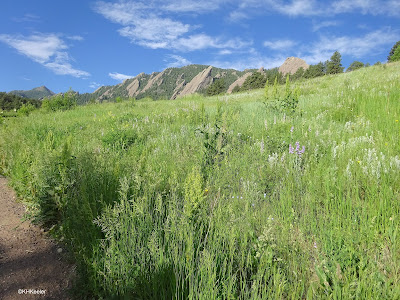 |
The idea for today's blog was to share photos of plants in dramatic landscapes across the world. I have thousands of photos, but very few are a scenic shot featuring a small plant. Some of that is the problem of focus: either the foreground or the background is in focus. Some is that I never thought to take such pictures. I will try in the future. But, enjoy these:
A field of mustards in bloom in central Tokyo (likely Brassica rapa planted by the park):
My yard has very little lawn, meaning areas with a monoculture of grass. Northern Colorado is too dry for standard varieties of Kentucky bluegrass, so having extensive grass wasn't water-efficient, and when we moved here, I was very conscious of the low rainfall of the region. Secondly, the need to keep a grass lawn mowed meant that the shaggy lawn would signal that we were away, back when we took extended trips. Third, my husband, the chief lawn-mower, didn't enjoy the activity.
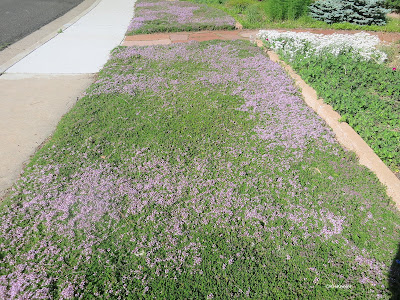 |
| Thyme lawn |
We had a blast of sleet and cold rain and now a forecast for rain and cool all week. So I'm posting pictures of tropical vines in flower. All year round, you can visit the tropics and see flowers. Not all these vines bloom year round, but when you see them, wow!
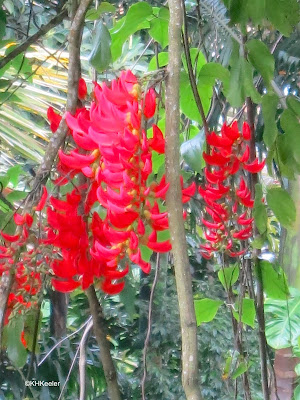 |
| red jade vine, Mucuna bennettii |
They are more wonderful in real life, with texture and scent, but I can only share photos today, so: enjoy.
Sweet alyssum is a pretty plant with white to purple flowers, frequently planted in gardens.
 |
| sweet alyssum, Lobularia maritima |
I am reading Robin Wall Kimmerer's Braiding Sweetgrass. I am going very slowly because the ideas are important to me. As Lawrence Durrell wrote in Balthazar, "one [idea] to be taken from time to time as needed and allowed to dissolve in the mind."